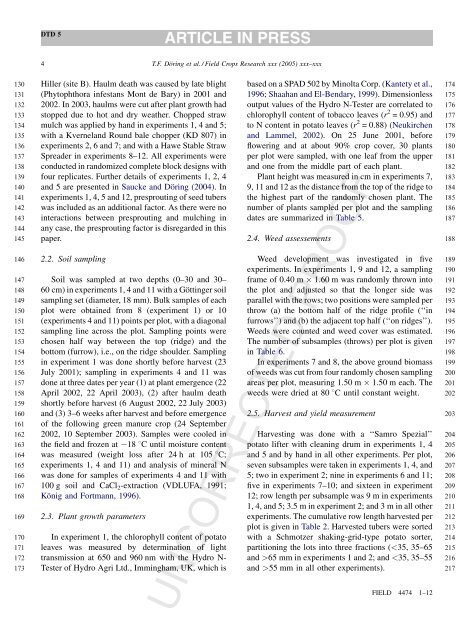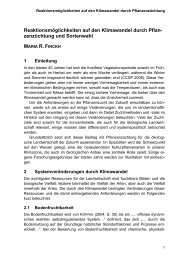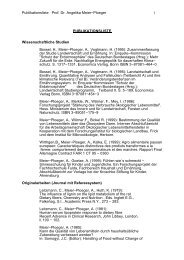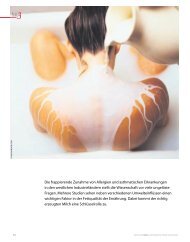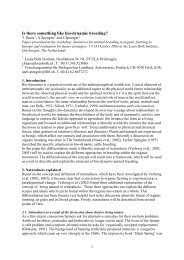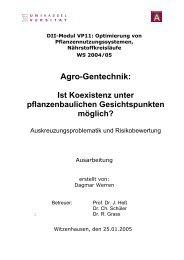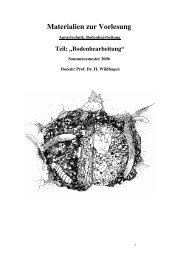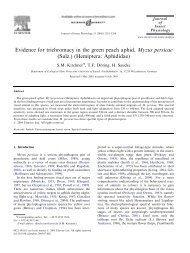Effects of straw mulch on soil nitrate dynamics
Effects of straw mulch on soil nitrate dynamics
Effects of straw mulch on soil nitrate dynamics
You also want an ePaper? Increase the reach of your titles
YUMPU automatically turns print PDFs into web optimized ePapers that Google loves.
130<br />
131<br />
132<br />
133<br />
134<br />
135<br />
136<br />
137<br />
138<br />
139<br />
140<br />
141<br />
142<br />
143<br />
144<br />
145<br />
146<br />
147<br />
148<br />
149<br />
150<br />
151<br />
152<br />
153<br />
154<br />
155<br />
156<br />
157<br />
158<br />
159<br />
160<br />
161<br />
162<br />
163<br />
164<br />
165<br />
166<br />
167<br />
168<br />
169<br />
170<br />
171<br />
172<br />
173<br />
DTD 5<br />
4<br />
Hiller (site B). Haulm death was caused by late blight<br />
(Phytophthora infestans M<strong>on</strong>t de Bary) in 2001 and<br />
2002. In 2003, haulms were cut after plant growth had<br />
stopped due to hot and dry weather. Chopped <str<strong>on</strong>g>straw</str<strong>on</strong>g><br />
<str<strong>on</strong>g>mulch</str<strong>on</strong>g> was applied by hand in experiments 1, 4 and 5;<br />
with a Kverneland Round bale chopper (KD 807) in<br />
experiments 2, 6 and 7; and with a Hawe Stable Straw<br />
Spreader in experiments 8–12. All experiments were<br />
c<strong>on</strong>ducted in randomized complete block designs with<br />
four replicates. Further details <str<strong>on</strong>g>of</str<strong>on</strong>g> experiments 1, 2, 4<br />
and 5 are presented in Saucke and Döring (2004). In<br />
experiments 1, 4, 5 and 12, presprouting <str<strong>on</strong>g>of</str<strong>on</strong>g> seed tubers<br />
was included as an additi<strong>on</strong>al factor. As there were no<br />
interacti<strong>on</strong>s between presprouting and <str<strong>on</strong>g>mulch</str<strong>on</strong>g>ing in<br />
any case, the presprouting factor is disregarded in this<br />
paper.<br />
2.2. Soil sampling<br />
Soil was sampled at two depths (0–30 and 30–<br />
60 cm) in experiments 1, 4 and 11 with a Göttinger <strong>soil</strong><br />
sampling set (diameter, 18 mm). Bulk samples <str<strong>on</strong>g>of</str<strong>on</strong>g> each<br />
plot were obtained from 8 (experiment 1) or 10<br />
(experiments 4 and 11) points per plot, with a diag<strong>on</strong>al<br />
sampling line across the plot. Sampling points were<br />
chosen half way between the top (ridge) and the<br />
bottom (furrow), i.e., <strong>on</strong> the ridge shoulder. Sampling<br />
in experiment 1 was d<strong>on</strong>e shortly before harvest (23<br />
July 2001); sampling in experiments 4 and 11 was<br />
d<strong>on</strong>e at three dates per year (1) at plant emergence (22<br />
April 2002, 22 April 2003), (2) after haulm death<br />
shortly before harvest (6 August 2002, 22 July 2003)<br />
and (3) 3–6 weeks after harvest and before emergence<br />
<str<strong>on</strong>g>of</str<strong>on</strong>g> the following green manure crop (24 September<br />
2002, 10 September 2003). Samples were cooled in<br />
the field and frozen at 18 8C until moisture c<strong>on</strong>tent<br />
was measured (weight loss after 24 h at 105 8C;<br />
experiments 1, 4 and 11) and analysis <str<strong>on</strong>g>of</str<strong>on</strong>g> mineral N<br />
was d<strong>on</strong>e for samples <str<strong>on</strong>g>of</str<strong>on</strong>g> experiments 4 and 11 with<br />
100 g <strong>soil</strong> and CaCl2-extracti<strong>on</strong> (VDLUFA, 1991;<br />
König and Fortmann, 1996).<br />
2.3. Plant growth parameters<br />
In experiment 1, the chlorophyll c<strong>on</strong>tent <str<strong>on</strong>g>of</str<strong>on</strong>g> potato<br />
leaves was measured by determinati<strong>on</strong> <str<strong>on</strong>g>of</str<strong>on</strong>g> light<br />
transmissi<strong>on</strong> at 650 and 960 nm with the Hydro N-<br />
Tester <str<strong>on</strong>g>of</str<strong>on</strong>g> Hydro Agri Ltd., Immingham, UK, which is<br />
T.F. Döring et al. / Field Crops Research xxx (2005) xxx–xxx<br />
based <strong>on</strong> a SPAD 502 by Minolta Corp. (Kantety et al.,<br />
1996; Shaahan and El-Bendary, 1999). Dimensi<strong>on</strong>less<br />
output values <str<strong>on</strong>g>of</str<strong>on</strong>g> the Hydro N-Tester are correlated to<br />
chlorophyll c<strong>on</strong>tent <str<strong>on</strong>g>of</str<strong>on</strong>g> tobacco leaves (r 2 = 0.95) and<br />
to N c<strong>on</strong>tent in potato leaves (r 2 = 0.88) (Neukirchen<br />
and Lammel, 2002). On 25 June 2001, before<br />
flowering and at about 90% crop cover, 30 plants<br />
per plot were sampled, with <strong>on</strong>e leaf from the upper<br />
and <strong>on</strong>e from the middle part <str<strong>on</strong>g>of</str<strong>on</strong>g> each plant.<br />
Plant height was measured in cm in experiments 7,<br />
9, 11 and 12 as the distance from the top <str<strong>on</strong>g>of</str<strong>on</strong>g> the ridge to<br />
the highest part <str<strong>on</strong>g>of</str<strong>on</strong>g> the randomly chosen plant. The<br />
number <str<strong>on</strong>g>of</str<strong>on</strong>g> plants sampled per plot and the sampling<br />
dates are summarized in Table 5.<br />
2.4. Weed assessements<br />
Weed development was investigated in five<br />
experiments. In experiments 1, 9 and 12, a sampling<br />
frame <str<strong>on</strong>g>of</str<strong>on</strong>g> 0.40 m 1.60 m was randomly thrown into<br />
the plot and adjusted so that the l<strong>on</strong>ger side was<br />
parallel with the rows; two positi<strong>on</strong>s were sampled per<br />
throw (a) the bottom half <str<strong>on</strong>g>of</str<strong>on</strong>g> the ridge pr<str<strong>on</strong>g>of</str<strong>on</strong>g>ile (‘‘in<br />
furrows’’) and (b) the adjacent top half (‘‘<strong>on</strong> ridges’’).<br />
Weeds were counted and weed cover was estimated.<br />
The number <str<strong>on</strong>g>of</str<strong>on</strong>g> subsamples (throws) per plot is given<br />
in Table 6.<br />
In experiments 7 and 8, the above ground biomass<br />
<str<strong>on</strong>g>of</str<strong>on</strong>g> weeds was cut from four randomly chosen sampling<br />
areas per plot, measuring 1.50 m 1.50 m each. The<br />
weeds were dried at 80 8C until c<strong>on</strong>stant weight.<br />
2.5. Harvest and yield measurement<br />
Harvesting was d<strong>on</strong>e with a ‘‘Samro Spezial’’<br />
potato lifter with cleaning drum in experiments 1, 4<br />
and 5 and by hand in all other experiments. Per plot,<br />
seven subsamples were taken in experiments 1, 4, and<br />
5; two in experiment 2; nine in experiments 6 and 11;<br />
five in experiments 7–10; and sixteen in experiment<br />
12; row length per subsample was 9 m in experiments<br />
1, 4, and 5; 3.5 m in experiment 2; and 3 m in all other<br />
experiments. The cumulative row length harvested per<br />
plot is given in Table 2. Harvested tubers were sorted<br />
with a Schmotzer shaking-grid-type potato sorter,<br />
partiti<strong>on</strong>ing the lots into three fracti<strong>on</strong>s (65 mm in experiments 1 and 2; and 55 mm in all other experiments).<br />
UNCORRECTED PROOF<br />
FIELD 4474 1–12<br />
174<br />
175<br />
176<br />
177<br />
178<br />
179<br />
180<br />
181<br />
182<br />
183<br />
184<br />
185<br />
186<br />
187<br />
188<br />
189<br />
190<br />
191<br />
192<br />
193<br />
194<br />
195<br />
196<br />
197<br />
198<br />
199<br />
200<br />
201<br />
202<br />
203<br />
204<br />
205<br />
206<br />
207<br />
208<br />
209<br />
210<br />
211<br />
212<br />
213<br />
214<br />
215<br />
216<br />
217


